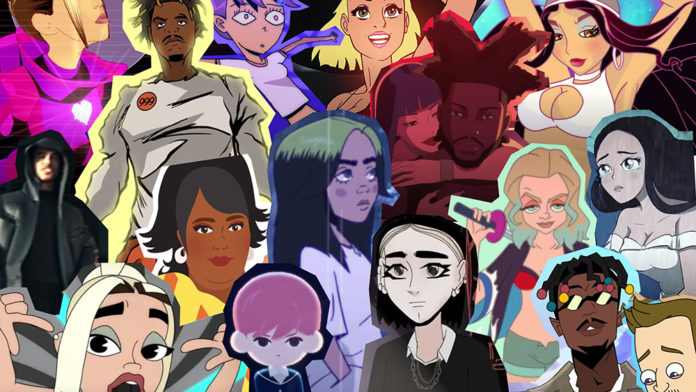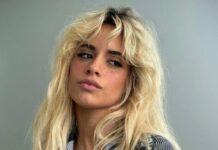COVID-19 proposed an important question: In our current image-obsessed age, how does a music artist continue projecting an iconic image when they can’t go on tour? The answer: They hire an animator.
As she often does, Billie Eilish had a visual in mind for her “My Future” music video: it would be night, lit by moonlight and framed by falling rain. She would be wearing Nikes, in that purple shade of white you see when your eyes adjust to the dark. Her hair would be loose, displaying her current style of dark ends and green roots. And all of it, from beginning to end, would be animated.
“It was March, it was quarantine, and it was raining in Los Angeles,” Chelsea Dodson, a member of Eilish’s creative team, tells Variety. “That was one of the first things she came to us with: ‘I know the style of rain I want, and I want this to start out rainy.’”
As a fan of anime, her team felt that this was a natural choice for Eilish and her brand, especially once they connected with artist and animator Andrew Onorato, based out of Chop Studio in Melbourne, Australia. Even within Eilish’s specific vision, he added his own creative touches: it was his idea to set the video in a garden, and also to create the adorably expressionless cartoon frog, a famed figure in the video’s YouTube comment section. His shining moment, however, came when Andrew hired a background painter to hand-paint the video’s backgrounds on the same paper that Studio Ghibli uses in their movies.
In an age where we can’t leave our homes, “My Future” allowed Billie Eilish to build a new world: a three-minute-and-thirty-second escape from reality. It also marked a growing shift in the music industry, as many artists turned to animation to create the vivid, fantastical scenes so many of us were missing.
“Every animator I know has been fully booked out all year,” says Onorato. “I’ve had so many more requests since quarantine. It has shown studios and agencies how viable animation is as an alternative to live action.”
When COVID-19 imposed lockdowns across the world in March, musicians were forced to rethink music videos — and as an industry that requires zero human contact, animation proved a popular choice. But without the opportunity to connect with their fans, it was more important than ever for artists to be central to the videos, if only in their animated forms. During the past few months of quarantine, YouTube has been flooded with a cast of digital duplicates: Looney Tunes Dua Lipa, bobble-headed BTS, vectorized Lizzo, 3-D rendered EARTHGANG, comic book Katy Perry, anime The Weeknd, manga Noah Cyrus, trippy Tame Impala, video game J. Balvin and Doja Cat with a Bratz pout.
Daniel Dinsenbacher, marketing director at Universal Music Group, notes that today’s audiences gravitate toward characters. “We always see more engagement when the content has the artist included in it,” Dinsenbacher says. “Even if it’s an animated version of the artist.”
Of course, the animated music video is not a concept that emerged during quarantine. Going back to the heyday of 1980s MTV, with iconic music videos like like A-Ha’s “Take On Me”, animated clips included everything from the Rolling Stones’ “Harlem Shuffle” to Paula Abdul’s “Opposites Attract.” The trend continued more sporadically through the 2000s, bringing iconic videos like Kanye West’s “Heartless” (2009), Daft Punk’s “One More Time “(2009), and Pearl Jam’s “Do the Evolution” (2009). (It is arguably relevant to note that the most viewed music video of all time is animated — that is, if you consider “Baby Shark” a song.)
But rarely has there been a flood of animated videos like during the coronavirus pandemic.
In an attempt to make up for lost revenue from concerts, touring, and in-person events, Dinsberger says companies are prioritizing streaming numbers. By “superserving” fans with multiple music videos per song — a traditional video, a lyric video and potentially a visualizer — they can introduce the music to more people.
Creating an animated music video is an experiment in hiring the right animator to enhance this brand. Like other up-and-coming Gen Z artists Mxmtoon and Beabadobee, BENEE adopted animated music videos before COVID-19 made them a necessity. On her YouTube channel, a “Glitter” video with doodled assets garners 11 million views and counting; on her Spotify, “Fire on Marzz” album artwork features BENEE’s cartoon head, alienized with four eyes; on her Instagram page, it’s not uncommon to spot the singer tagging her visual artists.
Her first fully-animated caricature appears in the video for “Night Garden,” released in March this year — a stunningly dark project with hair-raising hand-drawn assets in black, white and red, like a goth storybook. Though the quality is reminiscent of a full production studio, the entire video was created by a single 18-year-old illustrator from Russia named Alissa Ladeyshchikova.
She says that BENEE’s team messaged her on Instagram to hire her for the project, defining their intended aesthetic in one word: spooky.
The biggest challenge for Ladeyshchikova proved to be a common one, for music video animators: creating the artist’s character drawing.
“The first [attempt] was really my kind of style, but they wanted to be more anime-style. I drew so many heads. More realistic, less realistic.” It ended up taking three weeks of communication before she finally nailed the look.
A few of the many Stella heads
Alissa Ladeyshchikova
As Ladeyshchikova found, animators are often forced to strike a balance between their own artistic style and the desire of the client’s creative team. And for Onorato, the balance seems to fall in favor of the music industry.
“It’s always hard to describe your own style, especially when most of your career has been working on other people’s projects with set design styles and characters,” Onorato says. “I think it’s important to find the right balance between having work that feels ‘mine’ and tailoring it exactly to what the client is after.”
The artist’s creative teams have more control in the transaction, and the entire process is dependent on their schedule. From storyboarding to character designing to creation to completion, a single video might take anywhere from two weeks to four months. Ladeyshchikova, working on her own, spent three months on BENEE’s “Night Garden.” Onorato and Chop Studio spent five weeks on Eilish’s “My Future.”
“I think a lot of studios base this off live action schedules, which are so different,” Onorato adds. “You’ve got to come up with ideas and concepts, design all the characters, create all the backgrounds, hire about 10to 15 animators who are going to actually be free for three to four weeks, animate everything, and then composite it together.”
And that doesn’t even mention rounds of feedback — especially with so many animators based outside the U.S. Onorato and Eilish communicated over the 19-hour time difference between Melbourne and LA; Ladeyshchikova explained that she sent her assets and would go to sleep in Russia before BENEE even woke up in New Zealand.
Even though the timeline is a challenge, animators wouldn’t accept jobs if it weren’t worth it — and for Ladeyshchikova, working on a music video provided the perfect distraction from life on lockdown. “I really like making music videos because music is what inspired me to make animations,” she says. “I am really grateful for them. That they picked some Russian girl, this big American company, is really awesome.”
Source : Variety









